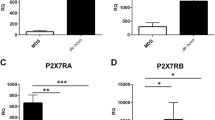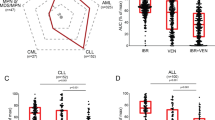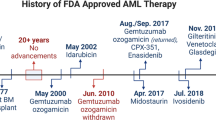Abstract
The TNF-related apoptosis-inducing ligand (TRAIL) is currently under evaluation as a possible (co-)therapeutic in cancer treatment. We therefore examined 129 cell samples from patients with de novo acute leukemia as to their constitutive susceptibility to TRAIL-induced apoptosis in vitro. Only 21 (16%) cell samples revealed at least 10% TRAIL-susceptible cells/sample as detected by flow cytometric annexinV staining after 24 h culture compared with medium control. Precursor B cell ALL samples (11 (27%) of 41) were more TRAIL-susceptible compared with AML (5 (9%) of 54; P < 0.05) but not compared with precursor t cell all (5 (15%) of 34; P = 0.20). Furthermore, we examined constitutive mRNA expression levels of TRAIL receptors R1–R4 by semi-quantitative RT-PCR (n = 58). Expression levels were heterogeneous, however, there was no significant correlation between the expression of the signal-transducing receptors (R1, R2) as well as of the decoy receptors (R3, R4) and TRAIL sensitivity in this series. Constitutive NF-κB activity has been shown to influence TRAIL susceptibility of leukemic cells. In 39 leukemic cell samples examined, we found a generally high NF-κB activity as detected by electrophoretic mobility shift assay which did not differ between TRAIL-susceptible and TRAIL-resistant cases. Finally, 49 acute leukemic cell samples were coincubated with doxorubicin in vitro. Doxorubicin sensitized four of 35 initially TRAIL-resistant samples and augmented TRAIL-induced apoptosis in two of 14 TRAIL-susceptible samples. In summary, constitutive TRAIL susceptibility differs between leukemia subtypes and does not correlate with mRNA expression levels of the TRAIL receptors R1–R4 as well as constitutive NF-κB activation status. The observed sensitization of leukemic cells to TRAIL by doxorubicin in vitro indicates that TRAIL should be further evaluated as to its possible role as an in vivo cotherapeutic in acute leukemia.
This is a preview of subscription content, access via your institution
Access options
Subscribe to this journal
Receive 12 print issues and online access
$259.00 per year
only $21.58 per issue
Buy this article
- Purchase on Springer Link
- Instant access to full article PDF
Prices may be subject to local taxes which are calculated during checkout




Similar content being viewed by others
References
Solary E, Droin N, Bettaieb A, Corcos L, Dimanche Boitrel MT, Garrido C . Positive and negative regulation of apoptotic pathways by cytotoxic agents in hematological malignancies Leukemia 2000 14: 1833–1849
Kaufmann SH, Earnshaw WC . Induction of apoptosis by cancer chemotherapy Exp Cell Res 2000 256: 42–49
Houghton JA . Apoptosis and drug response Curr Opin Oncol 1999 11: 475–481
Ashkenazi A, Dixit VM . Apoptosis control by death and decoy receptors Curr Opin Cell Biol 1999 11: 255–260
Griffith TS, Lynch DH . TRAIL: a molecule with multiple receptors and control mechanisms Curr Opin Immunol 1998 10: 559–563
Walczak H, Miller RE, Ariail K, Gliniak B, Griffith TS, Kubin M, Chin W, Jones J, Woodward A, Le T, Smith C, Smolak P, Goodwin RG, Rauch CT, Schuh JC, Lynch DH . Tumoricidal activity of tumor necrosis factor-related apoptosis-inducing ligand in vivo Nat Med 1999 5: 157–163
Ashkenazi A, Pai RC, Fong S, Leung S, Lawrence DA, Marsters SA, Blackie C, Chang L, McMurtrey AE, Hebert A, DeForge L, Koumenis IL, Lewis D, Harris L, Bussiere J, Koeppen H, Shahrokh Z, Schwall RH . Safety and antitumor activity of recombinant soluble Apo2 ligand J Clin Invest 1999 104: 155–162
Nagane M, Pan GH, Weddle JJ, Dixit VM, Cavenee WK, Huang HJS . Increased death receptor 5 expression by chemotherapeutic agents in human gliomas causes synergistic cytotoxicity with tumor necrosis factor-related apoptosis-inducing ligand in vitro and in vivo Cancer Res 2000 60: 847–853
Gliniak B, Le T . Tumor necrosis factor-related apoptosis-inducing ligand's antitumor activity in vivo is enhanced by the chemotherapeutic agent CPT-11 Cancer Res 1999 59: 6153–6158
Kim KH, Fisher MJ, Xu SQ, El Deiry WS . Molecular determinants of response to TRAIL in killing of normal and cancer cells Clin Cancer Res 2000 6: 335–346
Keane MM, Ettenberg SA, Nau MM, Russell EK, Lipkowitz S . Chemotherapy augments TRAIL-induced apoptosis in breast cell lines Cancer Res 1999 59: 734–741
Jo M, Kim T-H, Seol D-W, Esplen J, Dorko K, Billiar T, Strom S . Apoptosis induced in normal human hepatocytes by tumor necrosis factor-related apoptosis-inducing ligand Nat Med 2000 6: 654–657
Nitsch R, Bechmann I, Deisz RA, Haas D, Lehmann TN, Wendling U, Zipp F . Human brain-cell death induced by tumour-necrosis-factor-related apoptosis-inducing ligand (TRAIL) Lancet 2000 356: 827–828
Zamai L, Secchiero P, Pierpaoli S, Bassini A, Papa S, Alnemri ES, Guidotti L, Vitale M, Zauli G . TNF-related apoptosis-inducing ligand (TRAIL) as a negative regulator of normal human erythropoiesis Blood 2000 95: 3716–3724
Sheikh MS, Fornace AJ Jr . Death and decoy receptors and p53-mediated apoptosis Leukemia 2000 14: 1509–1513
Gibson SB, Oyer R, Spalding AC, Anderson SM, Johnson GL . Increased expression of death receptors 4 and 5 synergizes the apoptosis response to combined treatment with etoposide and TRAIL Mol Cell Biol 2000 20: 205–212
Clodi K, Wimmer D, Li Y, Goodwin R, Jaeger U, Mann G, Gadner H, Younes A . Expression of tumour necrosis factor (TNF)-related apoptosis-inducing ligand (TRAIL) receptors and sensitivity to TRAIL-induced apoptosis in primary B-cell acute lymphoblastic leukaemia cells Br J Haematol 2000 111: 580–586
Snell V, Clodi K, Zhao S, Goodwin R, Thomas EK, Morris SW, Kadin ME, Cabanillas F, Andreeff M, Younes A . Activity of TNF-related apoptosis-inducing ligand (TRAIL) in haematological malignancies Br J Haematol 1997 99: 618–624
Gazitt Y, Shaughnessy P, Montgomery W . Apoptosis-induced by trail and TNF-alpha in human multiple myeloma cells is not blocked by bcl-2 Cytokine 1999 11: 1010–1019
Gazitt Y . TRAIL is a potent inducer of apoptosis in myeloma cells derived from multiple myeloma patients and is not cytotoxic to hematopoietic stem cells Leukemia 1999 13: 1817–1824
Zhao S, Asgary Z, Wang Y, Goodwin R, Andreeff M, Younes A . Functional expression of TRAIL by lymphoid and myeloid tumour cells Br J Haematol 1999 106: 827–832
Shiiki K, Yoshikawa H, Kinoshita H, Takeda M, Ueno A, Nakajima Y, Tasaka K . Potential mechanisms of resistance to TRAIL/Apo2L-induced apoptosis in human promyelocytic leukemia HL-60 cells during granulocytic differentiation Cell Death Differ 2000 7: 939–946
Song K, Chen Y, Goke R, Wilmen A, Seidel C, Goke A, Hilliard B . Tumor necrosis factor-related apoptosis-inducing ligand (TRAIL) is an inhibitor of autoimmune inflammation and cell cycle progression J Exp Med 2000 191: 1095–1104
Kaplan MJ, Ray D, Mo RR, Yung RL, Richardson BC . TRAIL (Apo2 ligand) and TWEAK (Apo3 ligand) mediate CD4+ T cell killing of antigen-presenting macrophages J Immunol 2000 164: 2897–2904
Fanger NA, Maliszewski CR, Schooley K, Griffith TS . Human dendritic cells mediate cellular apoptosis via tumor necrosis factor-related apoptosis-inducing ligand (TRAIL) J Exp Med 1999 190: 1155–1164
Martinez Lorenzo MJ, Alava MA, Gamen S, Kim KJ, Chuntharapai A, Pineiro A, Naval J, Anel A . Involvement of APO2 ligand/TRAIL in activation-induced death of Jurkat and human peripheral blood T cells Eur J Immunol 1998 28: 2714–2725
Jeremias I, Kupatt C, Baumann B, Herr I, Wirth T, Debatin KM . Inhibition of nuclear factor kappaB activation attenuates apoptosis resistance in lymphoid cells Blood 1998 91: 4624–4631
Wen J, Ramadevi N, Nguyen D, Perkins C, Worthington E, Bhalla H . Antileukemic drugs increase death receptor 5 levels and enhance Apo-2L-induced apoptosis of human acute leukemia cells Blood 2000 96: 3900–3906
Bennett JM, Catovsky D, Daniel MT, Flandrin G, Galton DA, Gralnick HR, Sultan C . Proposed revised criteria for the classification of acute myeloid leukemia. A report of the French–American–British Cooperative Group Ann Intern Med 1985 103: 620–625
Béné MC, Castoldi G, Knapp W, Ludwig WD, Matutes E, Orfao A, van't Veer MB . Proposals for the immunological classification of acute leukemias. European Group for the Immunological Characterization of Leukemias (EGIL) Leukemia 1995 9: 1783–1786
Béné MC, Bernier M, Casasnovas RO, Castoldi G, Knapp W, Lanza F, Ludwig WD, Matutes E, Orfao A, Sperling C, van't Veer MB . The reliability and specificity of c-kit for the diagnosis of acute myeloid leukemias and undifferentiated leukemias. The European Group for the Immunological Classification of Leukemias (EGIL) Blood 1998 92: 596–599
Creutzig U, Harbott J, Sperling C, Ritter J, Zimmermann M, Löffler H, Riehm H, Schellong G, Ludwig WD . Clinical significance of surface antigen expression in children with acute myeloid leukemia: results of study AML-BFM-87 Blood 1995 86: 3097–3108
Ludwig WD, Rieder H, Bartram CR, Heinze B, Schwartz S, Gassmann W, Löffler H, Hossfeld D, Heil G, Handt S, Heyll A, Diedrich H, Fischer K, Weiss A, Volkers B, Aydemir U, Fonatsch C, Gökbuget N, Thiel E, Hoelzer D . Immunophenotypic and genotypic features, clinical characteristics, and treatment outcome of adult pro-B acute lymphoblastic leukemia: results of the German multicenter trials GMALL 03/87 and 04/89 Blood 1998 92: 1898–1909
Karawajew L, Wuchter C, Ruppert V, Drexler H, Gruss HJ, Dörken B, Ludwig WD . Differential CD95 expression and function in T and B lineage acute lymphoblastic leukemia cells Leukemia 1997 11: 1245–1252
Wuchter C, Karawajew L, Ruppert V, Büchner T, Schoch C, Ratei R, Dörken B, Ludwig W-D . Clinical significance of CD95, Bcl-2 and Bax expression in adult de novo acute myeloid leukemia in context of P-glycoprotein function, maturational stage, and cytogenetics Leukemia 1999 13: 1943–1953
Karawajew L, Ruppert V, Wuchter C, Kösser A, Schrappe M, Dörken B, Ludwig W-D . Inhibition of in vitro spontaneous apoptosis by Il-7 correlates with upregulation of Bcl-2, cortical/mature phenotype, and better early cytoreduction in childhood T-ALL Blood 2000 96: 297–306
Blagosklonny MV . Cell death beyond apoptosis Leukemia 2000 14: 1502–1508
Kordes U, Krappmann D, Heissmeyer V, Ludwig WD, Scheidereit C . Transcription factor NF-kappa B is constitutively activated in acute lymphoblastic leukemia cells Leukemia 2000 14: 399–402
Wuchter C, Karawajew L, Ruppert V, Schrappe M, Harbott J, Ratei R, Dörken B, Ludwig W-D . Constitutive expression levels of CD95 and Bcl-2 as well as CD95 function and spontaneous apoptosis in vitro do not predict response to induction chemotherapy and relapse rate in childhood ALL Br J Haematol 2000 110: 154–160
Jeremias I, Herr I, Boehler T, Debatin KM . TRAIL/Apo-2-ligand-induced apoptosis in human T cells Eur J Immunol 1998 28: 143–152
Hu WH, Johnson H, Shu HB . Tumor necrosis factor-related apoptosis-inducing ligand receptors signal NF-kappaB and JNK activation and apoptosis through distinct pathways J Biol Chem 1999 274: 30603–30610
Leverkus M, Neumann M, Mengling T, Rauch CT, Brocker EB, Krammer PH, Walczak H . Regulation of tumor necrosis factor-related apoptosis-inducing ligand sensitivity in primary and transformed human keratinocytes Cancer Res 2000 60: 553–559
Griffith TS, Rauch CT, Smolak PJ, Waugh JY, Boiani N, Lynch DH, Smith CA, Goodwin RG, Kubin MZ . Functional analysis of TRAIL receptors using monoclonal antibodies J Immunol 1999 162: 2597–2605
Kim IK, Chung CW, Woo HN, Hong GS, Nagata S, Jung YK . Reconstitution of caspase-8 sensitizes JB6 cells to TRAIL Biochem Biophys Res Commun 2000 277: 311–316
Walczak H, Bouchon A, Stahl H, Krammer PH . Tumor necrosis factor-related apoptosis-inducing ligand retains its apoptosis-inducing capacity on Bcl-2-or Bcl-x(L)-overexpressing chemotherapy-resistant tumor cells Cancer Res 2000 60: 3051–3057
Kischkel FC, Lawrence DA, Chuntharapai A, Schow P, Kim KJ, Ashkenazi A . Apo2L/TRAIL-dependent recruitment of endogenous FADD and caspase-8 to death receptors 4 and 5 Immunity 2000 12: 611–620
Desagher S, Osen Sand A, Nichols A, Eskes R, Montessuit S, Lauper S, Maundrell K, Antonsson B, Martinou JC . Bid-induced conformational change of Bax is responsible for mitochondrial cytochrome c release during apoptosis J Cell Biol 1999 144: 891–901
Daniel PT . Dissecting the pathways to death Leukemia 2000 14: 2035–2044
Wulczyn FG, Krappmann D, Scheidereit C . The NF-kappa B/Rel and I kappa B gene families: mediators of immune response and inflammation J Mol Med 1996 74: 749–69
Luque I, Gelinas C . Rel/NF-kappa B and I kappa B factors in oncogenesis Semin Cancer Biol 1997 8: 103–111
Wang CY, Mayo MW, Baldwin AS Jr . TNF- and cancer therapy-induced apoptosis: potentiation by inhibition of NF-kappaB Science 1996 274: 784–787
Beg AA, Baltimore D . An essential role for NF-kappaB in preventing TNF-alpha-induced cell death Science 1996 274: 782–784
Wang CY, Mayo MW, Korneluk RG, Goeddel DV, Baldwin AS Jr . NF-kappaB antiapoptosis: induction of TRAF1 and TRAF2 and c-IAP1 and c-IAP2 to suppress caspase-8 activation Science 1998 281: 1680–1683
Jeremias I, Debatin KM . TRAIL induces apoptosis and activation of NFkappaB Eur Cytokine Netw 1998 9: 687–688
Krappmann D, Scheidereit C . Regulation of NF-kappa B activity by I kappa B alpha and I kappa B beta stability Immunobiology 1997 198: 3–13
Acknowledgements
We would like to thank G Czerwony, R Hoffmann, M Martin and K Liebezeit for their excellent technical assistance. The cell samples included in this study were sent from various hospitals in Germany participating in the ongoing ALL-BFM (coordinators: M Schrappe and H Riehm, Hannover), GMALL (coordinator: D Hoelzer, Frankfurt), AML-BFM (coordinators: U Creutzig and J Ritter, Münster) and AML-CG (coordinators: T Büchner, Münster; W Hiddemann, München; B Wörmann, Braunschweig; W Berdel, Münster) trials. We would like to thank the coordinators of the above studies for their continuous support as well as all clinicians providing cell samples for our investigations. This work was supported by the ‘Deutsche José Carreras Leukämie Stiftung’ (grant No. JCLS 1998/NAT-3 to CW) and the ‘Deutsche Leukämie-Forschungshilfe’ (DLFH-98.04).
Author information
Authors and Affiliations
Rights and permissions
About this article
Cite this article
Wuchter, C., Krappmann, D., Cai, Z. et al. In vitro susceptibility to TRAIL-induced apoptosis of acute leukemia cells in the context of TRAIL receptor gene expression and constitutive NF-κB activity. Leukemia 15, 921–928 (2001). https://doi.org/10.1038/sj.leu.2402131
Received:
Accepted:
Published:
Issue Date:
DOI: https://doi.org/10.1038/sj.leu.2402131
Keywords
This article is cited by
-
Rocaglamide breaks TRAIL resistance in HTLV-1-associated adult T-cell leukemia/lymphoma by translational suppression of c-FLIP expression
Cell Death & Differentiation (2011)
-
TRAIL receptor mediates inflammatory cytokine release in an NF-κB-dependent manner
Cell Research (2009)
-
The TRAIL apoptotic pathway in cancer onset, progression and therapy
Nature Reviews Cancer (2008)
-
Novel Therapies Targeting the Apoptosis Pathway for the Treatment of Acute Myeloid Leukemia
Current Treatment Options in Oncology (2007)
-
The sesquiterpene lactone parthenolide induces selective apoptosis of B-chronic lymphocytic leukemia cells in vitro
Leukemia (2006)



